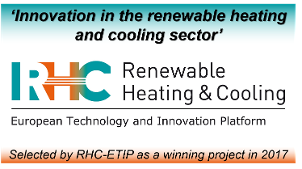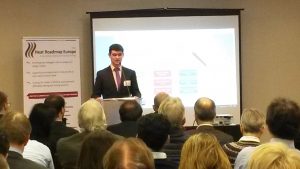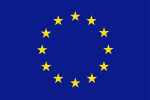Our Goal
 The goal of Heat Roadmap Europe 4 (HRE4) has been to develop low-carbon heating and cooling strategies, called Heat Roadmaps, by quantifying and implementing changes at the national level for 14 EU Member States, which together account for approximately 85-90% of total heating and cooling in Europe.
The goal of Heat Roadmap Europe 4 (HRE4) has been to develop low-carbon heating and cooling strategies, called Heat Roadmaps, by quantifying and implementing changes at the national level for 14 EU Member States, which together account for approximately 85-90% of total heating and cooling in Europe.
Specifically, we aim to:
- Build evidence that supports decarbonization of the heating and cooling sector in Europe.
- Redesign the energy sector by combining the knowledge of local waste heat conditions and potential savings with an energy system analysis.
- Promote transparency in energy research by sharing data, results, models and methodologies on open platforms as well as be open for new partnerships.
The State of Energy Today
 In Europe, there is a clear long-term objective to decarbonize the energy system, but it is very unclear how this will be achieved in the heating and cooling sector. As a result, there is currently a lot of uncertainty among policymakers and investors in the heating and cooling sector, primarily due to a lack of knowledge about the long-term changes that will need to occur in the coming decades. This HRE project will improve the knowledge in the heating and cooling sector and transfer it to key lead-users across policy, industry, and research. By doing so, it will enable new policies and prepare the ground for new investments in new markets.
In Europe, there is a clear long-term objective to decarbonize the energy system, but it is very unclear how this will be achieved in the heating and cooling sector. As a result, there is currently a lot of uncertainty among policymakers and investors in the heating and cooling sector, primarily due to a lack of knowledge about the long-term changes that will need to occur in the coming decades. This HRE project will improve the knowledge in the heating and cooling sector and transfer it to key lead-users across policy, industry, and research. By doing so, it will enable new policies and prepare the ground for new investments in new markets.
Our Approach
The Heat Roadmap Europe methodology has developed continually, allowing for both a better understanding as well as a more accurate quantification of the European heating and cooling sector. Key to the project is the combination of mapping and modelling, in order to be able to understand not just the system effects of energy efficiency, but also the spatial dimension.
Achievements
- The first ever quantification of the heating and cooling demand in Europe, both for today as well as forecast of their future development.
- The first ever pan-European thermal atlas (Peta) of the heating and cooling demand in Europe.
- The first ever quantification of the excess heat volumes available from power plants, waste incineration, and industry in Europe, all of which can be utilised on district heating networks.
- The first ever quantification of renewable resources available for district heating networks in Europe, including large-scale solar thermal, direct geothermal, and heat pumps.
- The first ever comparison at European level between the cost of heat savings and sustainable heat supply. This comparison is currently a major point of interest in EU energy policy, since it has altered the common belief that heat savings alone will be enough to decarbonise the heat sector.
- The first ever hourly models that simulated the impact of district heating and cooling, including their impact on the electricity and industrial sectors. These models are distributed freely online, thus enhancing the capacity of others to also analyse the impact of district heating and cooling.
- The first ever study to demonstrate how a simultaneous expansion of heat savings, district heating, and heat pumps will result in the cheapest low-carbon heat sector for Europe. The modelling tools used by the European Commission did not have the ability to adequately simulate the expansion of district heating and cooling, so the results from this analysis have already been utilised by EU policymakers to inform their ongoing work.

As recognition of the innovative methodology that HRE4 developled and deployed the Steering Committee of the European Technology and Innovation Platform on Renewable Heating & Cooling (RHC-ETIP) selected Heat Roadmap Europe 4 as most innovative project in the technology category of hybrid systems in June 2017. Read more here.
Key Messages
 Decarbonising Heating and Cooling requires energy efficiency on both the demand and supply side of the heat sector.
Decarbonising Heating and Cooling requires energy efficiency on both the demand and supply side of the heat sector.
Heat Savings can cost-effectively reduce the total heat demand in Europe by approximately 30-50%.
District Heating can capture excess heat, which is currently being wasted, and can replace fossil energy sources to heat EU cities. Based on cost and energy considerations, district heating should increase from today’s level of 10% up to 50% by 2050. Suitable urban areas for district heating are outlined in the mapping.
Individual Heat Pumps connect cheap renewable electricity production (such as wind and solar) with efficient renewable heat production (due to their COP). They should supply the majority of the heat demand in low heat-density areas, typically outside of the towns and cities.
Large heat pumps and other proven technologies can provide next generation district heating with renewable heat.
Energy System: Thermal storage is approximately 100 times cheaper than electricity storage, so introducing district heating and heat pumps will play a key role in accommodating larger penetrations of wind and solar electricity, in line with the Smart Energy System approach.
Impact
 Heat Roadmap Europe 4 has been an important contributor to the construction of knowledge in the heat and cooling sector. The new data, tools, methodologies, and results are an outcome of the integrated assessment of a variety of knowledge across different disciplines, such as: energy system analysis, heat savings, district heating and cooling, GIS mapping, and renewable energy.
Heat Roadmap Europe 4 has been an important contributor to the construction of knowledge in the heat and cooling sector. The new data, tools, methodologies, and results are an outcome of the integrated assessment of a variety of knowledge across different disciplines, such as: energy system analysis, heat savings, district heating and cooling, GIS mapping, and renewable energy.
Apart from the events which were organised or hosted by the project, members of the HRE4 consortium were invited to present the results of HRE at more than 120 events, ranging from one-to-one meetings with local, national, and EU policymakers, as well as key industrial and research partners such as Danfoss, Vattenfall, and the Joint Research Centre (which is the research branch of the European Commission).
Find more about events, mentions in the Press, references and quotes on Enabling Policy.
Project Specifics
 This project, which has received funding from the European Union’s Horizon 2020 research and innovation programme under grant agreement No. 695989, addresses topic EE-14-2015 “Removing market barriers to the uptake of efficient heating and cooling solutions” of the Energy-efficiency Call.
This project, which has received funding from the European Union’s Horizon 2020 research and innovation programme under grant agreement No. 695989, addresses topic EE-14-2015 “Removing market barriers to the uptake of efficient heating and cooling solutions” of the Energy-efficiency Call.
HRE4 kicked-off in March 2016 and ran for three years until February 2019. The project information is available at CORDIS, European Commission repository.